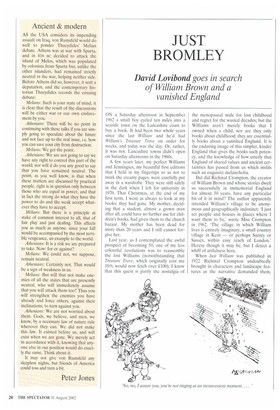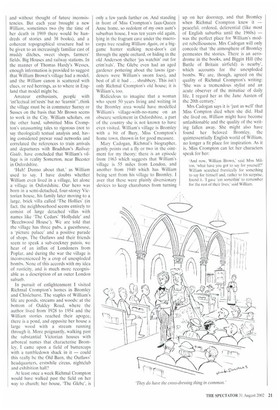JUST BROMLEY
David Lovibond goes in search
of William Brown and a vanished England
ON a Saturday afternoon in September 1962 a small boy cycled ten miles into a seaside town on the Lancashire coast to buy a book. It had been two whole years since the last William and he'd had William's Treasure Trove on order for weeks, and today was the day. Or, rather, it was not. Lancashire towns didn't open on Saturday afternoons in the 1960s.
A few years later, my perfect Williams and Jenningses, my beautiful first editions that I held in my fingertips so as not to mark the creamy pages, were carefully put away in a wardrobe. They were still safely in the dark when I left for university in 1970. That Christmas, at the end of my first term, I went as always to look at my books: they had gone. My mother, deciding that a student, almost a grown man after all, could have no further use for children's books, had given them to the church bazaar. My mother has been dead for more than 20 years and I still cannot forgive her.
Last year, as I contemplated the awful prospect of becoming 50, one of my less colourful resolutions was to reassemble the lost Williams (notwithstanding that Treasure Trove, which originally cost me 10/6, would now fetch over f100). I know that this quest is partly the nostalgia of
the menopausal male for lost childhood and regret for the wasted decades; but the Williams aren't merely books that I owned when a child, nor are they only books about childhood; they are essentially books about a vanished England. It is the enduring image of this simpler, kinder England that gives the books such potency, and the knowledge of how utterly that England of shared values and ancient certainties has passed from us which instils such an exquisite melancholia.
But did Richmal Crompton, the creator of William Brown and whose stories dwelt so successfully in immemorial England for almost 50 years, have any particular bit of it in mind? The author apparently intended William's village to be anonymous and geographically indistinct: 'I just set people and houses in places where I want them to be,' wrote Miss Crompton in 1962. 'The village in which William lives is entirely imaginary, a small country village in Kent — or perhaps Surrey or Sussex, within easy reach of London.' Heresy though it may be, but I detect a whiff of artfulness here.
When Just William was published in 1922 Richmal Crompton undoubtedly brought in characters and landscape features as the narrative demanded them,
and without thought of future inconsistencies. But each year brought a new William, sometimes two (by the time of her death in 1969 there would be hundreds of stories and 38 books), and a coherent topographical structure had to be given to an increasingly familiar cast of muddy ditches, sweet shops, farmers' fields. Big Houses and railway stations. In the manner of Thomas Hardy's Wessex, enough information is provided to suggest that William Brown's village had a model, and the William canon is scattered with clues, or red herrings, as to where in England that model might be.
Amateur enthusiasts, people with Inelectual int'rests' but no learnin",think the village must be in commuter Surrey or Sussex on the basis that Mr Brown seems to work in the City. William scholars, on the other hand, submitted Miss Cromp ton's unassuming tales to rigorous (not to say theological) textual analysis and, hav ing considered prewar road networks and correlated the references to train arrivals and departures with Bradshaw's Railway Guide, have concluded that William's village is in reality Somerton. near Bicester in Oxfordshire.
'Huh! Dunno about that.' as William used to say. I have doubts whether William even lived in a village, let alone a village in Oxfordshire. Our hero was born in a semi-detached, four-storey Vic torian house, his family later moving to a large, brick villa called 'The Hollies' (in fact, the neighbourhood seems entirely to consist of large detached villas with names like 'The Cedars' Hollydale' and `Beechwood House'). We are told that the village has three pubs, a guesthouse, a 'picture palace' and a positive parade of shops. The Outlaws and their friends seem to speak a sub-cockney patois, we hear of an influx of Londoners from Poplar, and during the war the village is inconvenienced by a crop of unexploded bombs. None of this accords with my idea of rusticity, and is much more recognisable as a description of an outer London suburb.
In pursuit of enlightenment I visited Richmal Crompton's homes in Bromley and Chislehurst. The staples of William's life are ponds, streams and woods: at the bottom of Oakley Road, where the author lived from 1928 to 1954 and the William stories reached their apogee, there is a pond, and opposite her house a large wood with a stream running through it. More poignantly, walking past the substantial Victorian houses with arboreal names that characterise Bromley, I came upon a field of buttercups with a tumbledown shack in it — could this really be the Old Barn, the Outlaws' headquarters, erstwhile circus, nightclub and exhibition hall?
At least once a week Richmal Crompton would have walked past the field on her way to church; her house, 'The Glebe', is only a few yards further on. And standing in front of Miss Crompton's faux-Queen Anne home, so redolent of my own aunt's suburban house, I was ten years old again, lying in the fragrant cave under the macrocarpa tree reading William Again, or a biggame hunter stalking next-door's cat through the apple orchard, or hiding in the old Anderson shelter jus watchin' out for crim'nals'. The Glebe even had an aged gardener pottering about the lawns (gardeners were William's sworn foes), and best of all it had . shrubbery. This isn't only Richmal Crompton's old house; it is William's, too.
Ridiculous to imagine that a woman who spent 50 years living and writing in the Bromley area would have modelled William's village-with-no-name on an obscure settlement in Oxfordshire, a part of the country she is not known to have even visited. William's village is Bromley with a bit of Bury. Miss Crompton's home town, thrown in for good measure.
Mary Cadogan, Richmal's biographer, gently points out a fly or two in the ointment for my theory: there is an episode from 1963 which suggests that William's village is 55 miles from London, and another from 1940 which has William being sent from his village to Bromley. I aver that these were plainly diversionary devices to keep charabancs from turning up on her doorstep, and that Bromley when Richmal Crompton knew it — peaceful, ordered, deferential (like most of English suburbia until the 1960s) — was the perfect place for William's modest rebelliousness. Mrs Cadogan will only concede that the atmosphere of Bromley permeates the stories. There is an aerodrome in the books, and Biggin Hill (the Battle of Britain airfield) is nearby', which accounts for the unexploded bombs. We are, though, agreed on the quality of Richmal Crompton's writing: 'She was a tremendous stylist and an acute observer of the minutiae of daily life. I regard her as the Jane Austen of the 20th century.'
Mrs Cadogan says it is 'just as well' that Miss Compton died when she did. Had she lived on, William might have become unfashionable and the quality of the writing fallen away. She might also have found her beloved Bromley, the quintessentially English world of William, no longer a fit place for inspiration. As it is. Miss Crompton can let her characters speak for her:
'And now, William Brown,' said Miss Milton, 'what have you got to say for yourself?' William searched frantically for something to say for himself and, rather to his surprise, found it. I gave 'ern somethin' to remember for the rest of their lives,' said William.



























































 Previous page
Previous page